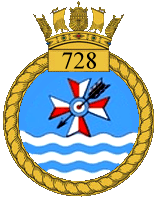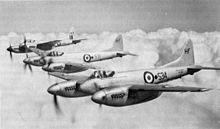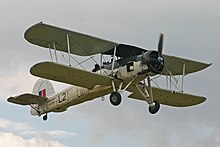Type a search term to find related articles by LIMS subject matter experts gathered from the most trusted and dynamic collaboration tools in the laboratory informatics industry.
| 728 Naval Air Squadron | |
|---|---|
 728 NAS badge | |
| Active | 1 May 1943 - 4 July 1943 14 August 1943 - 31 May 1967[1] |
| Country | |
| Branch | |
| Type | Fleet Air Arm Second Line Squadron |
| Role | Fleet Requirements Unit |
| Size | Squadron |
| Part of | Fleet Air Arm |
| Motto(s) | Docendo discimus (Latin for 'We learn by teaching') |
| Aircraft | See Aircraft flown section for full list. |
| Insignia | |
| Squadron Badge Description | Blue, upon a base wavy white two bars wavy blue chief a Maltese Cross per pale red and white there on a hurt surmounted by a plate surmounted by a torteau pierced by an arrow point downward in bend sinister feathered black (1953)[2] |
| Identification Markings | single letters (all types) M8A+ (1944) 500-599, 801-812 & 901-903 (1946) 570-599, 621-624, 655-659 & 956-961 (January 1956) 860-866 (July 1965)[3] |
| Tail Codes | HF (1946 – 1967)[4] |

728 Naval Air Squadron (728 NAS) was a Naval Air Squadron of the Royal Navy's Fleet Air Arm (FAA). It was formed at the beginning of May in 1943, as a Fleet Requirements Unit, at RN Air Section Gibraltar. It provided detachments at RN Air Section Tafaraoui, in Algeria and later at RAF Oujda in Morocco. Moving to HMS Grebe, RNAS Dekheila, in Egypt, during June, it then merged into 775 Naval Air Squadron during July. It reformed in August, again as a Fleet Requirements Unit, at HMS Grebe, moving immediately to RN Air Section Takali, Malta. It provided target towing both for the Royal Navy's Mediterranean Fleet and the British Army, before later providing a detachment to tow targets for the United States Navy at Naples, Italy.[5] The squadron remained on Malta, alternating between the airbases at Ta Kali, Luqa and Hal Far, until disbanding at the latter, in May 1967.[1]
728 Naval Air Squadron was formed on 1 May 1943 at RN Air Section Gibraltar, the Admiralty having lodger facilities at RAF North Front, Gibraltar, as a Fleet Requirements Unit. The squadron was equipped with Boulton Paul Defiant TT.1, an interceptor aircraft converted for target tug operations and Fairey Swordfish I, a biplane torpedo bomber.[6] Whilst at Gibraltar it operated detachments at RN Air Section Tafaraoui, (lodger facilities at RAF Tafaraoui) in Algeria, from 11 May 1943 to 15 June 1943, with Fairey Swordfish aircraft,[7] and also at RAF Oujda, in Morocco, with Boulton Paul Defiant to provide target towing for an American Anti-Aircraft battery firing range.[5] before moving to RNAS Dekheila (HMS Grebe), Alexandria in Egypt, on 15 June 1943,[6] where it later disbanded, being absorbed by 775 Naval Air Squadron on 4 July 1943.[5]
However, just over one month later, on the 14 August, 728 Naval Air Squadron reformed at RNAS Dekheila.[8] The squadron soon moved to Malta and settled at RNAS Hal Far (HMS Falcon), from 5 May 1946, after brief stints at RN Air Section Takali (HMS Goldfinch) and RAF Luqa and just after taking up radar calibration duties from No. 255 Squadron RAF.[4] It was again equipped with Boulton Paul Defiant target tug aircraft, and provided target towing both for the Royal Navy’s Mediterranean Fleet and the British Army, before later providing a detachment to tow targets for the United States Navy at Naples, Italy.[5]
1944 saw the squadron received new aircraft types with Miles Martinet, a target tug aircraft, Bristol Beaufighter, a multirole combat aircraft and Hawker Hurricane single-seat fighter aircraft added to the inventory as the British Pacific Fleet worked up in the Mediterranean.[1] The Boulton Paul Defiant aircraft were withdrawn and replaced by with Bristol Beaufort, a British torpedo bomber, Martin Baltimore, an American light bomber and reconnaissance aircraft, Supermarine Seafire, a navalised version of the Supermarine Spitfire fighter aircraft and de Havilland Mosquito, a twin-engine multirole combat aircraft, during the winter of 1944-45.[5]
With the post Second World War reduction of the Mediterranean Fleet, aircraft numbers were also reduced and changes in type took place. In 1949 de Havilland Mosquito TT Mk.39, a RN target towing variant, replaced the Miles Martinet target tug aircraft, later marks of Supermarine Seafire were used for fighter exercises, and Beech Expeditor, an American trainer, transport and utility aircraft, operated passenger and cargo flights. In 1951, de Havilland Sea Vampire jet fighter replaced the Supermarine Seafire and in 1952 the squadron received de Havilland Sea Hornet fighter aircraft and Short Sturgeon target tug aircraft replaced the de Havilland Mosquito TT Mk.39.[1]
Helicopters were added to supplement the squadron's inventory when it started operating the Westland Dragonfly HR.3, air-sea search and rescue helicopter, at the end of 1952. 728B Flight was the identity given to the new RNAS Hal Far SAR (Search and Rescue) flight, this operated utilising the Westland Whirlwind HAR.3, air-sea search and rescue variant, which arrived in 1957. In March 1963, Westland Whirlwind HAS.22, an anti-submarine helicopter, became available for the SAR flight, which was then amalgamated into 728 Naval Air Squadron.[4]
On 31 May 1967 728 Naval Air Squadron disbanded at RNAS Hal Far (HMS Falcon).[8]
The squadron operated a variety of different aircraft and versions:[9][3]




728 Naval Air Squadron operated from a number of overseas naval air stations of the Royal Navy, Royal Air Force stations, and a number of other air bases:[3]
1943
1943 - 1967
List of commanding officers of 728 Naval Air Squadron with date of appointment:[5][3]
1943
1943 - 1967